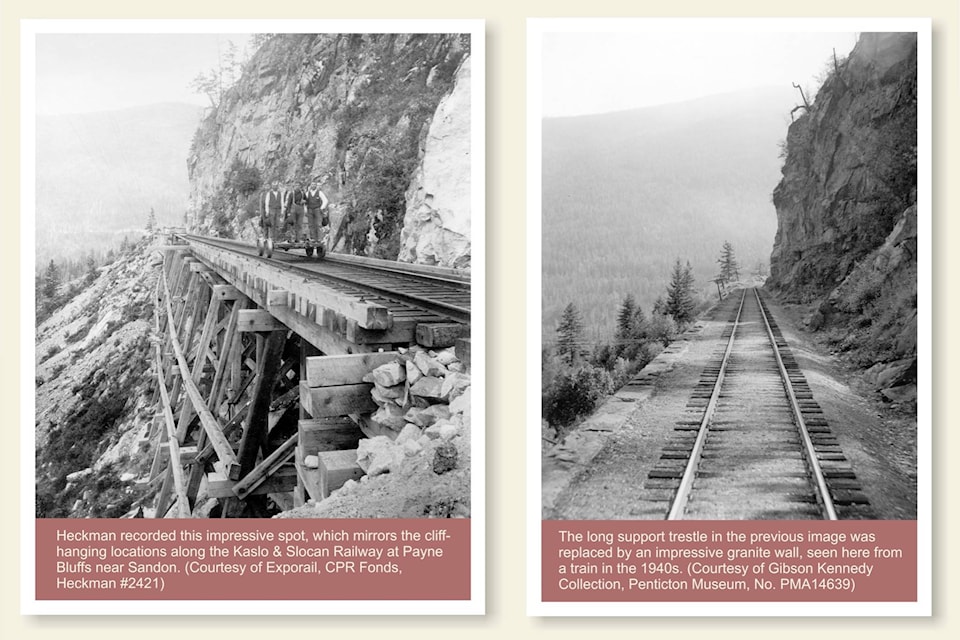By far the most challenging and expensive part of the Boundary extension of the Columbia &Western Railway was the segment along Lower Arrow Lake to Bull Dog Tunnel.
Construction commenced in June 1898. Work was facilitated by Lower Arrow Lake, which provided water transport to two key locations. At Shields Landing construction materials were unloaded from steamers and transported to the railway grade by horse-powered wagons. Engineering offices were located here for the Arrow Lake segment of the railway. Some supplies were also delivered to a temporary landing at McCormack Creek to support work in that vicinity.
A larger and more important supply centre was located at Brooklyn. A wagon road was rushed ahead, climbing steeply until it met the grade 1,700 feet above the lake, near the future portal of Bull Dog Tunnel. Construction supplies and heavy equipment were hauled along this tote road, which roughly paralleled the right-of-way of the railway to Christina Lake. In this way it was possible to develop the grade at many locations simultaneously, and to advance supporting infrastructure such as sawmills for timbers and ties to where they were needed.
Brooklyn, of course, took advantage of all this activity to flower almost immediately into a boomtown, on what was formerly William Parker`s pre-emption. For one hectic year the town put on pretentious airs, with its ten hotels and an opera house, and then it just as quickly faded away as the action moved down the line.
The grade really commenced at Labarthe, where a turntable was eventually installed so that pusher engines on what became known as the Farron Hill could be turned around. Four shorter tunnels were drilled and blasted through rocky outcrops, with the Labarthe Tunnel (now flooded) being the first. The fifth, Bull Dog Tunnel, was bypassed by a series of switchbacks until it came into service in 1900.
Much blasting had to take place to secure a toehold for the railway on the steep mountainside. Accidents were inevitable, and took their toll in human lives in 1898:
August: John Wilson (hurled by boulder into the abyss).
October: John Kinnear, Oscar Anderson, and Thomas Lanehan (killed by blasting accident).
October: Oscar Johnson (killed by flying rock).
November: John Olson (tamping stick driven through heart.)
Others died in camp from various causes, including suicide. Heckman’s 1901 photographs documented the recently completed railway with its amazing array of trestles, which supported the railway on steep rock faces and provided temporary crossings of creeks and bridged deep ravines.
A decade after original construction was completed, CPR commenced in replacing the original wood trestles with more permanent improvements. Massive retaining walls, constructed of quarried granite, replaced some of the earlier trestles, as can be seen in the illustration provided. Some creeks like Moberley and Brooklyn were diverted into culverts or flumes, and the rail bed was filled in. The three deepest ravines, however, were spanned by new steel bridges. McCormack and Cub creeks have nearly identical structures; Farr Creek, however stands out because of its long central span and the double through truss design.
As the erection of the massive steel bridges would have required very high wooden false-work, a different solution was employed by the contractor, Hamilton Steel Works.
Two tall steel support towers were erected, with rock foundations deep in the canyon. The first bridge components (plate girders) were then assembled by working outward from the two end abutments onto the first stone piers located high up the ravine. The larger and heavier truss segments were then assembled outward until they came to rest on the tall support towers, and from these, the assembly continued on the cantilevered segments until they met in the middle, at a great height over the creek. The three bridges are engineering marvels and worthy of admiration.
The new Columbia &Western Railway from West Robson to Midway was an amazing accomplishment achieved at a great cost. Thomas Shaughnessy, who took over as CPR president in 1899, stated that the cost of the line was, per mile, the highest in CPR history.
The most expensive portion in both, financial outlay and lives lost, was on the Arrow Lake Grade. Shaughnessy visited the line in October 1899, when the Bull Dog tunnel was nearing completion. On the return trip his private coach derailed on the switchbacks above the tunnel, and he decided to relocate to the caboose.
His feelings about the episode are not recorded, but most likely he saw it as a small bump in a road, of which he could be truly proud.
